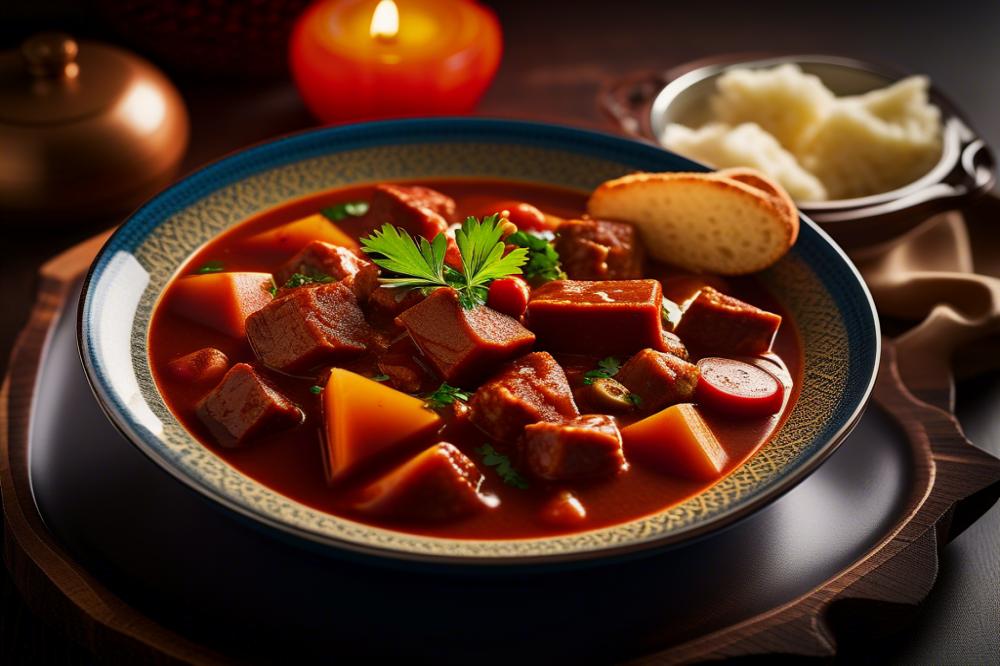Exploring Polish Goulash and Stew Variations
Polish Goulash holds a special place in Polish cuisine. This hearty dish is more than just food; it represents tradition and cultural richness. Every family has its own version, reflecting personal tastes and regional influences. Comfort food, such as this, plays a crucial role in culinary adventure holidays. Travelers often seek familiar yet exciting dishes that evoke warmth and satisfaction. Meeting locals over a bowl of goulash can turn a meal into a shared experience, creating lasting memories.
Exploring the variations of Polish goulash and Polish Stew opens a window to regional differences within the country. Various ingredients and cooking methods contribute to a diversity of flavors. Many recipes feature meats such as beef or pork, while others might highlight vegetables unique to a specific area. Some regions boast spicy variations, while others embrace milder, soothing flavors. Each dish tells a story, connecting the past to the present. Understanding this history deepens appreciation for each unique plate.
Every spoonful of goulash or stew invites you to discover the comforts of Polish cuisine. The blending of spices, careful preparation of ingredients, and traditional cooking methods all come together in a delightful symphony. As we explore these dishes, each recipe reveals the heart of Polish culture, nourishing both the body and soul. The culinary landscape is a testament to the warmth and creativity of its people. So, let’s embark on this flavorful journey through the world of Polish goulash and diverse stew variations.
Understanding Polish Goulash
Polish goulash is a beloved dish that combines hearty flavors with simple ingredients. This comforting meal has roots in culinary traditions that date back centuries. While some may think of goulash as simply a thick stew, it encompasses a range of recipes and variations that reflect regional differences across Poland. The charm of Polish goulash lies in its adaptability, where different families may add their own touches to create a unique palate experience.
Definition and Traditional Preparation Methods
The foundation of this dish typically involves simmering meat with vegetables in a rich sauce. Traditionally, cooks use beef or pork as primary proteins. They often spice it with paprika and caraway seeds, enhancing the depth of flavors. Many recipes utilize a slow-cooking method to tenderize the meat while melding the ingredients over time. As a result, the stew develops a warm and savory aroma that fills the home.
Key Ingredients Commonly Used in Polish Goulash
Essential components of goulash include potatoes, carrots, and onions. Each adds a different texture and flavor to the dish. Other ingredients may feature bell peppers or mushrooms, which reflect local ingredients found in various regions. The choice of meat also varies, with some regions opting for poultry instead of the more traditional beef or pork. Fresh herbs such as parsley or dill often find their way in as a garnish, adding brightness to the final presentation.
Culinary Significance and Historical Background of the Dish
The history of Polish goulash is rich and diverse. Influences from neighboring countries have shaped many traditional recipes. It serves not only as a sustenance option but also as comfort food for gatherings and family meals. Many Poles cherish this dish for its ability to bring people together. Variations exist depending on seasonal ingredients and local customs, making it an integral part of Poland’s culinary heritage.
In homes and restaurants alike, goulash represents a connection to the past. Recipes passed down through generations tell stories of family traditions and gatherings. Every bowl of this delicious stew offers a taste of history and communal warmth. Embracing Polish goulash means exploring a delightful array of flavors and an understanding of Polish culture.
Variations of Polish Goulash
Exploring Regional Differences Across Poland
Poland is a country rich in history and culture, and this diversity is reflected in its culinary landscape. Each region offers its own take on goulash, creating a tapestry of flavors and cooking methods. For instance, in the southern areas, hearty ingredients like mushrooms and wild game are often included. These additions provide a deeper flavor profile compared to more common urban variations, which might focus on beef and potatoes. Such differences highlight how local resources and traditions influence recipes.
Common Variations in Ingredients and Cooking Methods
When examining Polish Stew, one can find variations that go beyond the standard recipe. Some families prefer to use kohlrabi or even rutabagas to add a twist. The choice of meat varies too. While beef is popular, some regions lean towards pork or even venison. Cooking methods also differ. Some cooks choose to braise their dishes slowly, allowing the flavors to meld beautifully, while others might opt for a quicker method that retains a fresh taste. These decisions not only shape the taste, but also reflect regional preferences for comfort food.
Examples of Local Adaptations and Unique Recipes
In Silesia, one might encounter a variant known as “szczawiówka,” which incorporates sorrel for a tangy flavor. In northern Poland, a seafood adaptation exists that replaces traditional meats with fresh fish, showcasing the region’s access to the Baltic Sea. Each of these recipes tells a story of location, history, and local ingredients. Families often hand down their secrets, adding yet another layer of personal touch to the dish. These adaptations create a wonderful array of options for anyone looking to explore these comforting meals.
Diverse Stew Recipes in Poland
Poland offers a variety of stews that beautifully complement its famous goulash. Each dish brings a different set of flavors and ingredients to the table. Examples include the beloved bigos, often referred to as hunter’s stew. This dish combines sauerkraut, fresh cabbage, and assorted meats. Its rich, hearty character makes it a staple during colder months.
Another favorite is wazanka, a robust dish from the northern regions. This stew mixes meat, vegetables, and wild mushrooms, showcasing regional ingredients. The cooking methods can vary, with some recipes calling for slow cooking to enhance the flavors. Families often pass down their unique recipes, preserving the culinary history of their ancestors.
When comparing these stews to goulash, it’s clear that the spices and textures differ. While goulash boasts a smoky, paprika flavor, bigos thrives on the tanginess of fermented cabbage. Variations in each recipe provide a glimpse into the cultural influences across Poland. Regional differences influence what ingredients locals use. For example, areas near forests may emphasize mushrooms while southern regions might lean on hearty meats.
Stews play a crucial role in Polish culinary culture. They serve as comfort food, warming the hearts of families. Often enjoyed during gatherings, these dishes foster a sense of togetherness. Serving traditional stews symbolizes a connection to home, history, and heritage. Each bowl tells a story of the past, inviting people to experience Poland’s diverse flavors and cooking traditions.
Flavor Profiles and Ingredients
Polish goulash is a delicious dish that showcases the rich flavors of Poland. At its core, this hearty meal combines tender meat and vegetables in a savory sauce. Many dishes include beef, pork, or even game meat, providing a variety of taste experiences. Each protein contributes a distinctive flavor, making every bite a discovery. Variations in recipes allow cooks to personalize their meals based on preferences and available ingredients.
Common herbs and spices play a crucial role in enhancing traditional recipes. Paprika, with its warm, smoky essence, is often a star player in goulash dishes. Garlic and onions add depth and sweetness, while caraway seeds introduce an earthy note. These key flavors create layers that delight the palate. People often appreciate how these elements combine harmoniously, making the stew comforting and inviting.
Seasonal ingredients significantly impact regional goulash variations. In the fall, root vegetables like carrots and potatoes are plentiful, adding heartiness to the dish. Spring may bring fresh greens and herbs, brightening the goulash and giving it a vibrant feel. Cooks adjust their recipes to embrace what is fresh and local. This adaptation expands the history of goulash while showcasing the diversity of Polish cuisine.
Cooking methods also affect flavor profiles and textures. Slow-cooking traditionally allows flavors to meld deeply, creating a rich, satisfying stew. Some people prefer a quicker method, opting for pressure cooking techniques that yield tender meat in less time. Each approach produces unique but equally enjoyable results. Overall, the journey through Polish goulash is one filled with comfort food experiences that can warm the heart and delight the taste buds.
Culinary Adventure Holidays in Poland
Traveling to Poland offers a delightful journey into its food culture. For food lovers, exploring opportunities for culinary tourism centered around goulash can be an exciting experience. Authentic Polish cuisine features various dishes that highlight the comfort food aspect of this hearty meal. Food enthusiasts will appreciate the chance to delve into the rich history and regional differences that shape these recipes.
Cooking Classes and Tasting Experiences Available
Engaging in cooking classes will teach you traditional cooking methods. Local chefs often share their secrets, showcasing the unique ingredients that make each dish special. Imagine chopping fresh vegetables while learning to blend spices that create unforgettable flavors. Many classes also include tasting sessions, allowing participants to experience the depth and warmth of Polish stews. Savoring these meals in their homeland only enhances the joy of each bite.
Recommendations for Discovering Authentic Polish Dishes
To truly experience Polish goulash, you should visit local markets and eateries. Try small family-run restaurants that pride themselves on their traditional recipes. Each region offers variations that reflect its culture and ingredients. Don’t hesitate to ask the locals where to find the best renditions of these classic foods. Food festivals also showcase seasonal dishes and offer tastings that can introduce you to diverse flavors. Embrace this culinary adventure, as it promises an enriching exploration of Poland’s culinary heritage.
Final Thoughts on Polish Goulash and Its Culinary Significance
Polish goulash is more than just a dish; it reflects a rich history woven through the fabric of Polish culture. Variations abound, showcasing regional ingredients and family traditions that have been passed down through generations. Each recipe has its own character, influenced by local preferences and available produce. This diversity makes the stew a true representation of Poland’s culinary landscape.
As a comfort food, goulash holds a special place in the hearts of many. Its warm, hearty nature brings a sense of satisfaction and nostalgia. On cold, winter evenings, a bowl of this stew can provide not just warmth but also a comforting reminder of home. Meals like this foster connections, bringing families together around the table.
Exploring Polish goulash opens up opportunities for culinary adventures. Consider embarking on a holiday dedicated to tasting these diverse dishes. Visiting Poland offers a chance to experience authentic flavors that can’t be replicated elsewhere. Immersing yourself in local cuisine not only satisfies the palate but also broadens your understanding of a culture that values tradition and family.
Diving into the world of goulash can be a journey worth taking. You may find that the flavors speak to you in unexpected ways. Each bowl tells a story, inviting you to delve deeper into the past while enjoying the present. Embrace the chance to explore this delightful comfort food, and let it lead you on a flavorful adventure.



